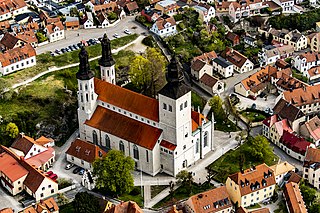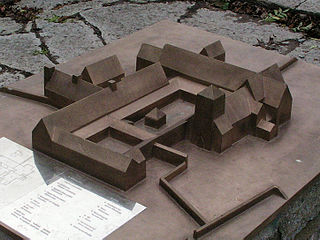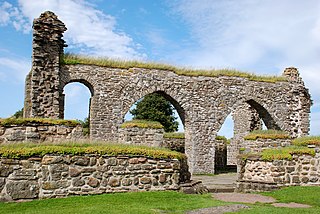
Solberga Abbey (Swedish: Solberga kloster), was a Cistercian nunnery in Sweden, in operation from 1246 until at least 1469. It was located outside Visby on Gotland until 1404, and then in Visby. It was the only nunnery on the island of Gotland.

Solberga Abbey (Swedish: Solberga kloster), was a Cistercian nunnery in Sweden, in operation from 1246 until at least 1469. It was located outside Visby on Gotland until 1404, and then in Visby. It was the only nunnery on the island of Gotland.
Solberga Abbey was likely a daughter convent of Vreta Abbey. On 12 August 1246, Bishop Laurentius of Linköping mentions that the first nuns had been sent to Gotland. This likely refers to Solberga, which was the only nunnery on the island. In contrast to what was previously believed, Solberga was a large convent with many members. It had both an abbess and a prioress. In 1361, many fallen from the Battle of Visby was buried on the abbey's land, where a cross, which still stands, was erected.
The abbey was presumably destroyed by the war between the Victual Brothers, the Teutonic Knights and the forces of the Kalmar Union in 1398–1403. In 1404, the abbess applied for help from the Master of the Teutonic Knights in Prussia, then in control of Gotland, to found a new abbey. The nuns were allowed to reside in the St. Jacob chapel in Visby. From 1469, they lived by the St. Gertrud chapel in Visby. During the 15th century, the nuns were still, event though no longer in residence at Solberga, referred to as the Solberga nuns. It is not known exactly when the nunnery was dissolved. It may not have lasted until the reformation. By 1469, the nuns were described as "the diminished nuns of Visby".

Visby is an urban area in Sweden and the seat of Gotland Municipality in Gotland County on the island of Gotland with 24,330 inhabitants as of 2017. Visby is also the episcopal see for the Diocese of Visby. The Hanseatic city of Visby is arguably the best-preserved medieval city in Scandinavia, and, since 1995, it has been on the UNESCO World Heritage Site list. Among the most notable historical remains are the 3.4 km (2.1 mi) long town wall that encircles the town center, and a number of church ruins. The decline as a Hanseatic city in the Late Middle Ages was the cause for many stone houses being preserved in their original medieval style.

The Diocese of Linköping is a diocese within the Church of Sweden administering the Östergötland County, the north eastern part of Jönköping County and the northern part of Kalmar County. It comprises nine deaneries subdivided into 176 parishes with a total of 443,000 members. The diocese's largest parish is Motala. The Diocese of Linköping has a rank directly below the Archdiocese of Uppsala of the Church of Sweden. The current bishop is Marika Markovits.

The Battle of Visby was fought in 1361 near the town of Visby on the island of Gotland, between the forces of the Danish king and the Gutnish country yeomen. The Danish force was victorious.

Lichtenthal Abbey is a Cistercian nunnery in Lichtenthal in the town of Baden-Baden, Germany.

Heggbach Abbey was a Cistercian nunnery in Heggbach, now part of the municipality of Maselheim in the district of Biberach, Baden-Württemberg, Germany.

Ljugarn is a locality on the Swedish island of Gotland, with 200 inhabitants in 2014. It is located at the east coast of the island in Ardre south of Slite. It is regarded as a popular and quiet area as well as holiday village for tourists and vacationers. Ljugarn is the oldest seaside resort in Gotland, and was formerly a port, fishing village, pilot station and the county seat of Ljugarn County. The 1.5 km (0.93 mi) long flat sandy beach, one of the longest in Gotland, is visited throughout the year. Since the early 20th century the village has had pensions, restaurants, hostels, coffee-shops and a grocery store.

Vreta Abbey, in operation from the beginning of the 12th century to 1582, was the first nunnery in Sweden, initially Benedictine and later Cistercian, and one of the oldest in Scandinavia. It was located in the present-day municipality of Linköping in Östergötland.

Wienhausen Abbey or Convent near Celle in Lower Saxony, Germany, is a community of Evangelical Lutheran women, which until the Reformation was a Cistercian Catholic nunnery. The abbey owns significant artworks and artifacts, including a collection of tapestries and the earliest surviving example of a type of eyeglasses.

Nonneseter Abbey was a Cistercian nunnery in Bergen, Norway. A small part of the former abbey church remains in use as a chapel, the Nonneseter kapell.
Bakke Abbey was a medieval nunnery in Trondheim in Norway.

St. Clare's Priory, Stockholm, was a Roman Catholic nunnery of the Poor Clares in Stockholm, Sweden that was active from 1289 to the Swedish Reformation in 1527.

Gudhem Abbey is the ruin of a nunnery which was in operation from 1152 to 1529. It is located in Gudhem outside Falköping in the Falbygden area in Västergötland, Sweden. It was initially part of the Benedictine and later Cistercian order. It is considered to have been one of the oldest convents in Sweden; after Vreta Abbey (1100) and Alvastra Abbey (1143).

Riseberga Abbey, was a Cistercian nunnery in Sweden, in operation from circa 1180 until 1534. It was located near Fjugesta in Närke. It had the right to appoint the vicar of the Edsberg parish, which was under the jurisdiction of the abbey. The ruins of the buildings are preserved, and the Amphitheatre of the abbey are presently used as a Sylvan theater.

Gnisvärd, is a fishing village in Tofta on the central west coast of the island of Gotland, Sweden. Gnisvärd is mostly known for its stone ships and harbor.

Ardre is a populated area, a socken, on the Swedish island of Gotland. It comprises the same area as the administrative Ardre District, established on 1 January 2016. It is most noted for the Viking Ardre image stones found under the floor boards of the Ardre Church.

Pehr Magnus Arvid Säve was a Swedish teacher, cultural historian and artist. He was the initiator of the Gotlands Fornvänner society and Gotland Museum.

Askeby Abbey was a Cistercian nunnery in operation from the late 12th century until 1529. It was located in Askeby outside Linköping, Sweden.
The War in Gotland (1403–1404) was a conflict between the Kalmar Union and the Teutonic Order. The war was a failure for Margaret, and the island stayed in Teutonic hands until they eventually sold the island in 1407.